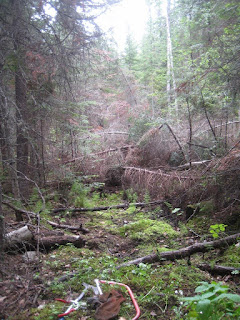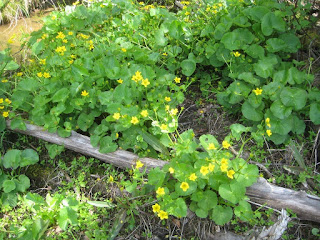Approaching the exit of the long lake in a light rain on June 12 after leaving camp 4, where a river tumbles towards the next body of water, I land on the right hand side just where the rapids start.
Walking down the portage trail along the rapids, I find it is clogged with dozens of down trees, probably felled with heavy snow fall. Most of the fallen trees are relatively small - balsam fir, with some spruce, alder and birch, but I soon encounter a big tree that I will not be able to cut with my bow saw. It appears to be several years since anyone has cleared the path. I manage to make my way about 150 metres by ducking under, climbing over and detouring to one side. Having walked this far, I am quite confident that this is the portage to get me forward. According to the map, the rapids extend at least 500 metres, so even my younger self knows there will be no portaging today. The rapids are not runnable, with boulders, trees and falls obstructing them. Any canoeist without a good saw would not portage through this mess.
I unpack my tools to clear the start of the portage so the canoe can be dragged past where I will establish a campsite. Some gear gets stashed under the canoe.
I clear spots for camp setup after having canoed 10 km. Most of the gear is placed inside the nylon tent or in the tent vestibules. In-use gear is stored under the tarp shelter. In this damp weather, when it warms above 10℃, mosquitoes are quite bothersome under the tarp.
The Platypus™ water filter used last year to purify drinking water is defective, allowing water to run straight through. No problem, I have a brand new filter, but unfortunately it also fails! Aie ... not impressed! The directions state to avoid shaking the filters so perhaps storing in a barrel next time might be better. For the duration of the season I rely on boiled water, filling my two canteens with cooled water, and use the LifeStraw™ for drinking water when on the move at lunches, when setting up camp and on portages if I have depleted the canteen supply. This proves to be a good system, however, if there were two people it would be harder to keep up with enough boiled cool water for canteens.
I am drinking hot water at lunch using a stainless steel double-walled mug ("296 mL 10 fl oz GSI Outdoors Glacier Stainless Camp Cup"). Two of these mugs replace plastic cups and prove to be much more durable and healthier.
This fireplace site under a large spruce tree canopy proves to be a relatively dry spot during light rain and the mosquitoes are less bothersome. I clear and level a spot to situate the chair. There are 10 mergansers and several goldeneyes that are feeding constantly in the river beyond the fire.
The rain continues during much of my time at this campsite. Larger firewood keeps the fire alive.
The first harvest of fresh fireweed shoots, my favourite salad, picked when I stopped in a burned area while canoeing. I find that I can keep salad greens for two meals ahead if stored in a cooler in a moss "fridge".
While breaking off a stump for firewood, the stump gives way suddenly and I lunge ahead striking a limb that thankfully misses my eye. I strike it hard enough to produce a cut and a big bruise. Aie! I lecture myself on being more careful! If a branch or tree does not easily break, it is time to use the saw. Triple antibiotic ointment applied at bedtime helps to speed up the process of healing.
Weather continues to deteriorate, and on the second day in camp I erect the canvas tent and wood stove. It provides a nice respite from the 10℃ damp conditions and allows wet clothing to dry. The rain continues during the night as well as daytime. It would be nice if it only rained at night ... but never say no to rain. Mosquitoes are bothersome, and I burn a 5 cm piece of mosquito coil (0.25% d-cis/trans-allethrin) in the closed tent 30 minutes before bedtime, vacating the tent for that period to avoid the smoke of the burning coil.
The following photos show the process of clearing the 600 metre portage trail, taking five hours over a period of two days. Some spots are completely blocked with many down trees and have to be unjumbled in a specific order to be removed. It is mostly saw work, with some axe work to remove protruding limbs, and some pruner work for small trees and some branches. Big game has been detouring off to the side, meandering through the trees closer to the river. In some places it is hard to tell where the old trail is, so I walk ahead to make sure I am clearing the correct spot, sometimes working backwards to connect to the cleared trail. It rains on and off while working, and once it pours heavily and I get quite wet. Whether from rain or sweat I am going to get wet, but I can look forward to getting dry and to a change of clothes in the warm tent. Warblers sing in the rain to accompany me. The trail is quite level and there are only two small wet stretches where I can walk at the side. The lower end of the portage is down a steep slope beside the end of the rapids at a small falls which prove to provide good walleye fishing. There are several large trees that cannot be cut with my saw. Some I can step over, but two I have to portage loads under which is a pain because I must set the loads down and then pick them back up again. These two trees I have to lower the canoe and push the canoe across before picking it up again. (On my return trip, two canoeists with a chain saw have cut out these large trees, making the portage much easier. Thanks to Dave and Jim ... much appreciated!)
Before clearing.
After clearing.
Before clearing.
After clearing.
Before clearing.
After clearing.
Before clearing.
After clearing.
Before clearing.
After clearing.
Before clearing.
After clearing.
The lower rapids and falls where the walleye fishing is good. The canoe is tied up at the base of the falls where there is a good spot to clean fish.
Below the rapids, in the small lake, last year's forest fire is very evident along the shore on the one side. It provides lots of fresh fireweed salad greens.
Gulls and terns are finding lots to eat below the rapids.
On the third day in camp I canoe down the small lake below the rapids to the outlet and more rapids that must be portaged.
The 370 metre trail to the next lake only requires about one hour of clearing, a welcome change from the previous portage. There are lots of fireweed shoots to pick for salad greens.
Along the trail are many clubmosses which are notable because the dried spores when flung into the flames of a fire burn with a flash like gunpowder. Shamans in olden times used the spores for this purpose in their rituals to shock and awe.
The rapids in the river beside the portage are unrunnable.
Many shed casings (exuviae) of dragonfly nymphs on shore below the rapids. I think the gulls and terns are feeding on the nymphs that do not make it to shore to moult.
Yellow marsh-marigold. Leaves and flowers can reportedly be eaten after boiling in two changes of water to break down toxins. There are many other options for fresh salad, my favourite being fireweed.
My camp chair continues to hang on to life after I fashioned a thin corrugated plastic surface to reinforce the seat.
The attachment points of the Laundry Pail wire handle break, but I am able to fashion a rope handle through the remaining plastic. I will not be able to carry anything heavy using the new handle, but it will suffice to carry the pail on portages. Later I add a second complete layer of duct tape to reinforce the pail. I am still on the lookout for another 5 imperial gallon (23 litre) replacement.

















































